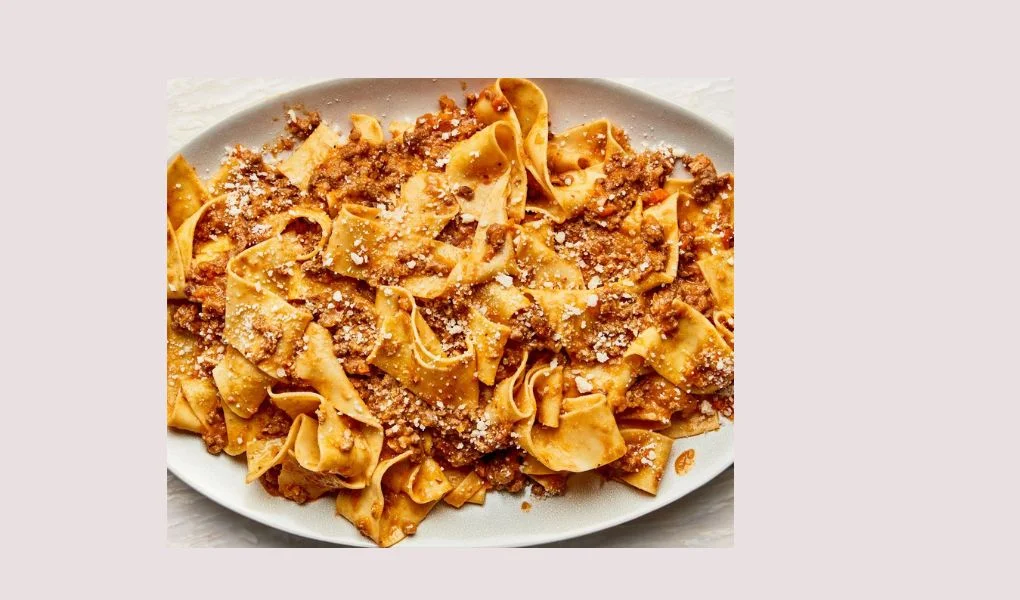When it comes to classic Italian cuisine, few dishes can compete with the richness and heartiness of Bolognese sauce. Renowned chef Andy Baraghani presents a mouthwatering Bolognese recipe that captures the essence of this traditional dish. In this article, we’ll delve into the ingredients, provide step-by-step instructions, share nutrition facts, and offer tips and reviews from the community. Whether you’re a seasoned cook or a beginner, this guide will help you create a delightful Bolognese that will impress family and friends.
Why This Recipe Stands Out
Andy Baraghani’s Bolognese recipe is celebrated for its simplicity and authenticity. By using quality ingredients and a slow cooking technique, the sauce develops deep flavors and a velvety texture that pairs perfectly with pasta. What makes this recipe unique is the combination of fresh vegetables, aromatic herbs, and rich meats, all simmered together to create a dish that is both comforting and indulgent.

Ingredients
Here’s what you’ll need to make Andy Baraghani’s Bolognese:
| Ingredient | Amount |
| Medium onion, chopped | 1 |
| Celery stalk, chopped | 1 |
| Small carrot, peeled and chopped | 1 |
| Extra-virgin olive oil | 3 tbsp |
| Ground beef chuck (20% fat) | 1 lb |
| Kosher salt | To taste |
| Thinly sliced pancetta | 3 oz |
| Dry white wine | 1 cup |
| Tomato paste | ⅓ cup |
| Bay leaf | 1 |
| Finely grated nutmeg | Pinch |
| Homemade chicken stock or low-sodium chicken broth | 2 cups (or more) |
| Whole milk | 1 cup |
| Fresh tagliatelle or pappardelle (or dry rigatoni) | 1 lb |
| Finely grated Parmesan | 2 oz (about ½ cup) plus more for serving |
Step-By-Step Instructions
Step 1: Prepare the Vegetables
- Pulse Vegetables: In a food processor, pulse the onion, celery, and carrot until very finely chopped. This mix will form the aromatic base of your sauce.
- Set Aside: Transfer the chopped vegetables to a small bowl.
Step 2: Brown the Beef
- Heat Oil: In a Dutch oven or large pot, heat the olive oil over medium heat.
- Cook Beef: Break the ground beef into small clumps (about 1½ inches) and add it to the pot. Lightly season with salt.
- Sear Meat: Cook for 6–8 minutes, stirring occasionally, until the beef is lightly browned but not crisp. It’s okay if it remains a little pink in the center.
- Transfer Beef: Using a slotted spoon, transfer the beef to a medium bowl and set aside.
Step 3: Cook the Pancetta
- Cook Pancetta: In the same pot, add the chopped pancetta and cook over medium heat, stirring occasionally, until it releases some of its fat and becomes crisp (about 6–8 minutes).
- Add Vegetables: Stir in the reserved onion mixture and cook until the vegetables are very soft and beginning to stick to the bottom of the pot (about 6–8 minutes).
Step 4: Combine Ingredients
- Return Beef: Add the browned beef back to the pot and pour in the dry white wine.
- Reduce Wine: Lower the heat to medium-low and cook, using a wooden spoon to smash down on the beef, until the wine has evaporated and the mixture is almost dry (about 12–15 minutes).
- Add Tomato Paste: Stir in the tomato paste, bay leaf, and nutmeg. Cook for another 5 minutes, stirring occasionally and pressing down on the meat.
Step 5: Slow Cook the Sauce
- Add Stock and Milk: Pour in the chicken stock and whole milk. Add a pinch of salt to taste.
- Reduce Heat: Turn the heat to the lowest setting and cook uncovered, stirring occasionally, for 2–2.5 hours. The sauce should release occasional small bubbles without boiling.
- Check Consistency: If the liquid reduces before the meat is completely tender, add an extra ½ cup of stock and continue cooking. Discard the bay leaf when finished and taste to adjust seasoning with salt.
Step 6: Cook the Pasta
- Boil Pasta: In a large pot, bring salted water to a boil. Cook the fresh pasta for about 3 minutes or dry pasta until very al dente (about 2 minutes less than package directions).
- Drain Pasta: Reserve 1 cup of pasta cooking liquid, then drain the pasta.
Step 7: Combine Pasta and Sauce
- Transfer Pasta: Using tongs, transfer the drained pasta to the pot with the Bolognese sauce.
- Add Cheese and Liquid: Add 1 cup of reserved pasta cooking liquid and ½ cup of finely grated Parmesan.
- Simmer: Increase the heat to medium, bring to a simmer, and cook, tossing constantly, until the pasta is al dente and the liquid slightly thickens (about 2 minutes).
Step 8: Serve
- Plate and Garnish: Transfer the pasta to a platter and top with additional Parmesan cheese. Serve hot.
Nutrition Facts
Here’s a breakdown of the nutrition for one serving of Bolognese (assuming 4 servings total):
| Nutrient | Amount per Serving |
| Calories | 600 |
| Protein | 30g |
| Carbohydrates | 65g |
| Dietary Fiber | 4g |
| Sugars | 5g |
| Total Fat | 25g |
| Saturated Fat | 10g |
| Cholesterol | 80mg |
| Sodium | 800mg |
Note: Nutritional values can vary based on the specific ingredients and quantities used.
Reviews
Community Praise:
- Flavorful and Rich: Many home cooks rave about the depth of flavor in Andy Baraghani’s Bolognese, with one reviewer stating, “This is the best Bolognese I’ve ever made! The slow cooking really brings out the flavors.”
- Perfect for Gatherings: Another reviewer mentions, “I made this for a family gathering, and everyone asked for the recipe. It’s perfect for feeding a crowd!”
- Easy to Follow: Many users appreciate the step-by-step instructions, saying, “I’m not an expert cook, but the detailed directions made it easy to follow.”
Community Tips and Praise
- Make Ahead: The sauce can be made up to 4 days in advance. Just cover and chill it, then reheat gently before serving.
- Freezing: This Bolognese sauce freezes well. Store it in an airtight container for up to 3 months.
- Additions: Some users suggest adding a pinch of red pepper flakes for a bit of heat or incorporating fresh herbs like basil and parsley for a fresher taste.
FAQs of Andy Baraghani’s Bolognese Recipe
- Can I use different types of meat?
Yes! While ground beef is traditional, you can substitute with ground pork, turkey, or a mixture of meats for a different flavor. - What pasta works best with Bolognese?
Fresh tagliatelle or pappardelle are excellent choices. However, dry rigatoni also pairs well due to its ability to hold the sauce. - How can I thicken my Bolognese sauce?
If the sauce is too thin, let it simmer uncovered for a bit longer to reduce. Alternatively, you can add a bit of cornstarch mixed with water. - What can I serve with Bolognese?
Serve your Bolognese with a simple side salad, garlic bread, or steamed vegetables to balance the meal.
Conclusion of Andy Baraghani’s Bolognese Recipe
Andy Baraghani’s Bolognese recipe is a timeless dish that brings warmth and satisfaction to any dining table. With its rich flavors, tender meat, and fresh pasta, this recipe is sure to become a favorite in your household. Whether you’re hosting a dinner party or enjoying a cozy night in, this Bolognese is perfect for any occasion. By following the step-by-step instructions and utilizing the tips from the community, you’ll be well on your way to mastering this classic Italian sauce. Enjoy your cooking adventure, and buon appetito!




